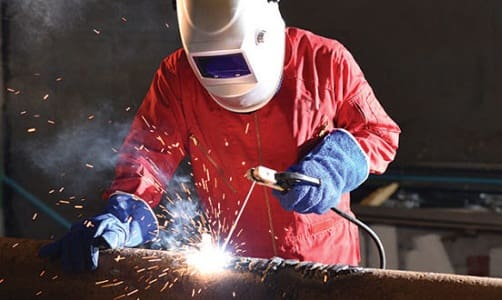Industrial Training Institute is a Gerald among the top educational courses offered in India today. Each course offered under ITI is top-notch and best. ITI welding course is one such course that is embedded by ITI. Even if ITI courses are well-known to most people in India. Most of them do not understand what the course is all about and assume it to be inferior to other courses.
Course Details of ItI
| Course Name | Course Duration | Eligibility | Course Type |
| ITI Welder Course | 2 Years | 10th Pass | Diploma |
ITI Welder Course Details
Unlike other courses, the ITI welder course or any ITI courses are designed in such a way that it offers training technical and non-technical fields of daily life. In simple words, the scope to get employed after this course is comparatively very higher than in another course. One of the main reasons for such a trend is because this course offers more practical training than other courses. When it comes to welding, an ITI welding graduate would have more practical knowledge at hand about welding than any other person.
The profession of welding is a vocational trade and it would exist as long as there are metals and alloys or nonmetals are in use. The ITI welding course extends over 2-years and it is commonly divided into 2 semesters. One semester per year. The course is designed to teach a candidate/student to fuse two or more metals/alloys/nonmetal.
ITI welding course eligibility
The eligibility of the ITI welder course could vary, however, we would list the general eligibility criteria for joining an ITI welding course.
- The applicant should have appeared for the 10th board exam from a government of India recognized school board.
- The applicant should have passed the 10th board exam with a minimum of 50% marks.
- For some ITI’s, the eligibility criteria could be 12th pass. Check the respective ITI’s for more information.
- ITI welder gas and electric course, the candidate needs to pass 8th from a government recognized school board.
ITI welding course pre-requisite skills
As already mentioned welding and ITI welding is different from most profession and courses. While most other courses have a more theoretical part to learn. ITI courses give more importance to practical knowledge and skills. If you are planning to become an ITI welder, here are some of the key skills you need to possess.
- The candidate should be patient
- He/she should be ready to work long hours
- He/she should be able to identify the materials and the possible welding method.
- He/she should be able to work long hours
- Welding is more practical work than theoretical work, therefore, the candidate should have a mindset to work.
ITI welder course: Syllabus
As already mentioned, ITI courses are different from other courses, the duration of the ITI welder course is 2-years and it is divided into 2 semesters. Each semester, the candidate has to learn almost 24 different subjects. Each subject could be taught practically or theoretically. The subjects taught could vary based on the institute/college/university. However, we have managed to collect a general syllabus that the ITI welding course commonly follows.
| Induction training |
| Importance of trade training |
| Machinery used in welding trade |
| Introduction to the safety equipment’s and tools |
| Filing square to dimension, hack sawing, cutting, etc. |
| General discipline of the course |
| Elementary first aid |
| Marking out on mild steel plate and punching on it |
| Importance of welding in today’s world and industry |
| Safety precautions to be taken before using metal arc, oxyacetylene welding |
| Setting up arc welding machine and using the accessories |
| Setting up oxy-acetylene welding machine and using the accessories |
| Surface cleaning |
| Introduction to process of metal joining |
| Introduction and definition of welding |
| All about welding different welding machine, tools, and its accessories |
| Various welding process and its application |
| How to use a welding machine efficiently |
| Different metal joining methods |
| Edge joint on mild steel sheet 2mm thick in flat position and one over the other |
| Marking and straight line cutting of Mild steel plate 10 mm thick |
| Bolting, soldering, brazing, riveting, and seaming, etc. |
| How to clean the surface of a welding plate |
| Edge preparation and fit up for different welding process |
| How to weld straight line beads on a 10mm thick mild steel plate in a flat position |
| Basic electricity applicable to different welding methods |
| Heat and temperature relation to different welding process |
| Principle of different welding processes |
| Welding a square butt joint on a 2mm thick mild steel plate |
| Welding fillet T joint on a 10mm thick mild steel plate in flat position |
| Common gases that could be used for different welding processes |
| Chemistry and working of oxyacetylene flame |
| Types of oxy-acetylene flame and its application |
| Welding open corner joint on 2mm thick mild steel plate |
| Arc welding power sources |
| Circular gas cutting on 10mm thick mild steel plate |
| Welding open corner joint on 10mm thick mild steel plate |
| Welding position as per Indian welding standards |
| Welding materials in flat, vertical, horizontal, and overhead position |
| General welding symbols used in a drawing |
| Weld slop and rotation according to Indian standard |
| Fillet lap join on a 2mm mild steel plate |
| Advantages of AC and DC welding machines |
| Polarity, uses, and application |
| Arc length, type, and uses of arc |
| Welding single v butt joint on a 12mm thick mild steel plate in flat position |
| Welding square butt joint on a mild steel plate of 2 mm thickness at horizontal position |
| Welding fillet T joint on a mild steel plate of 10mm thickness in horizontal position |
| Acetylene gas and its properties |
| Acetylene gas purifiers and how to use it |
| Oxygen gas and its properties |
| Air liquification and its use |
| Charging process of oxygen and other gases |
| Welding fillet lap joint on 2mm and |
| Calcium carbide uses and its key properties |
| Welding square butt joint on 2mm mild steel plate in vertical position |
| Fusion run on 2mm thick mild steel plate with filler rod in a vertical position |
| Gas welding techniques |
| Difference between gas cutting blow pipe and gas welding blow pipe |
| Gas welding technique, leftward and rightward |
| Welding fillet T joint on a 2mm and 10 mm thick mild steel plate |
| Manifold system |
| Pipe welding |
| Gas welding fluxes, types and functions |
| Gas brazing and soldering |
| Pipe welding and plate welding difference |
| Storage and baking of electrodes |
| Classification of steel |
| Weldability of metals and alloys |
| Importance of post and pre-heating while welding |
| Effects of alloying elements of steel |
| Types of stainless steel and type of welding possible |
| Cast iron, properties and how to weld it |
| Bronze welding of cast iron and how to do it |
ITI welder course: Fees –
The fees for an ITI welder course could vary based on the university/college/institute. Generally, a government college or university fee would be around INR 3000 per semester and when it comes to private college or university, the fees could be double, approximately around INR 10000 to 30000.
ITI welder course: Career
An ITI welder graduate has different career opportunities. Here are some of the common career options.
- Gas and electric welder
- Arc welder
- Pipe welder
- Fabricator
- Structural steel welder
- Welding helper
ITI welder course: Salary
As a fresher, an ITI welder could expect a salary around INR 10000 to 15000. Once, experienced, the salary could be close to INR 25000 to 35000. On the other hand, in middle eastern countries, the salary could be around INR 75000 to 80000. However, the workload and conditions of working would be entirely different from Indian standards in middle eastern countries.
Also Read: ITI Fitter Course: Details, Eligibility, Fees, and Career
ITI welding course is a good course and it could get you a good job. However, as already mentioned, candidates who have passed 8th from a recognized school could enroll in an ITI welder course. But, we recommend, that you enroll only after the 10th.

Rahul Kumar is a passionate educator, writer, and subject matter expert in the field of education and professional development. As an author on CoursesXpert, Rahul Kumar’s articles cover a wide range of topics, from various courses, educational and career guidance.




